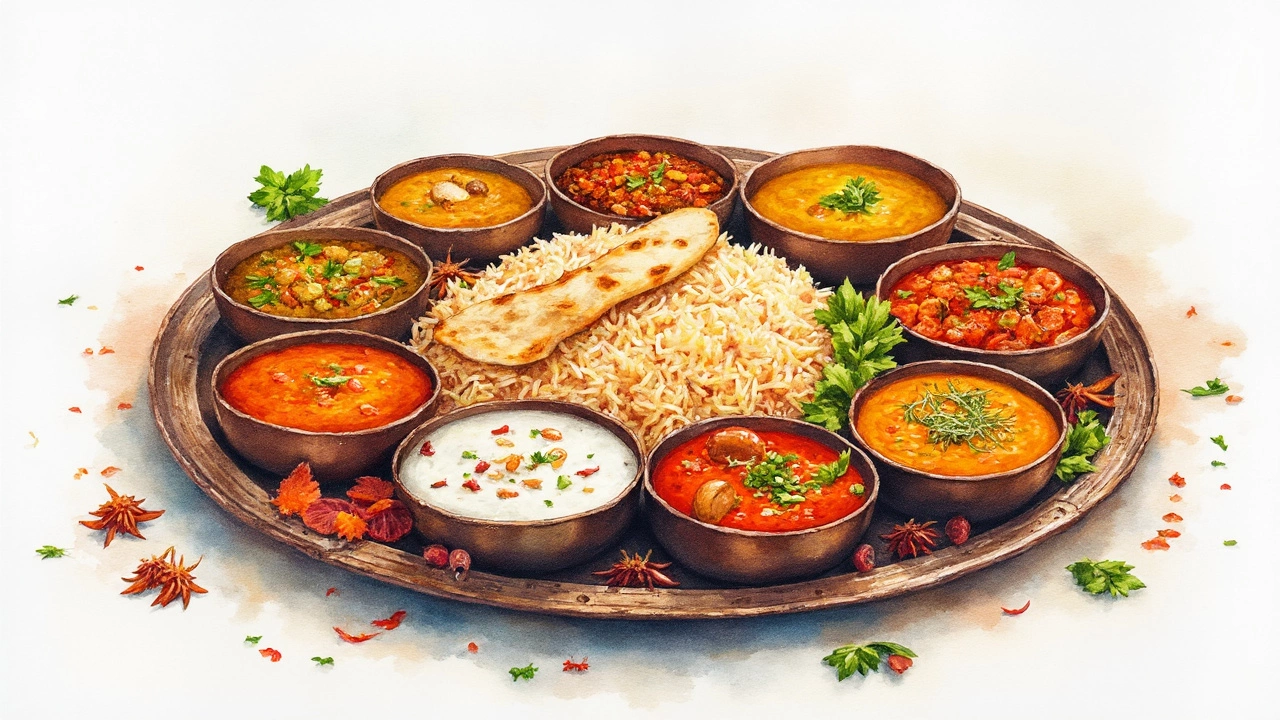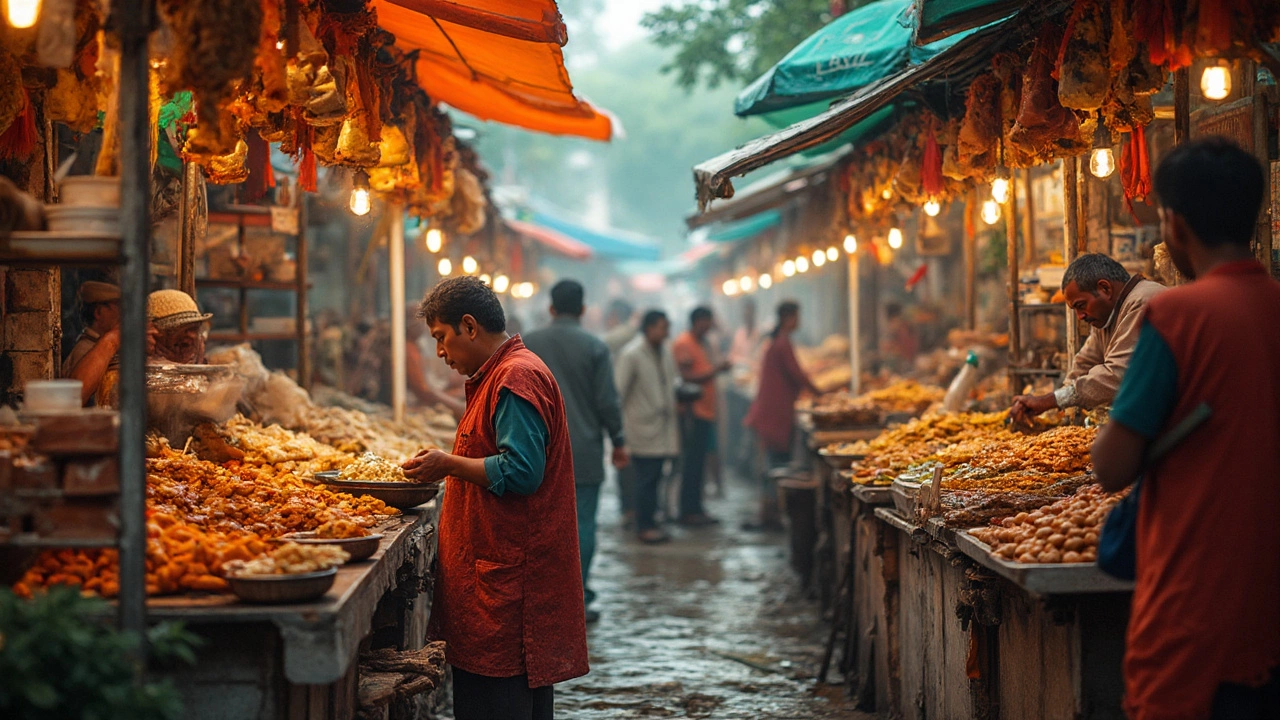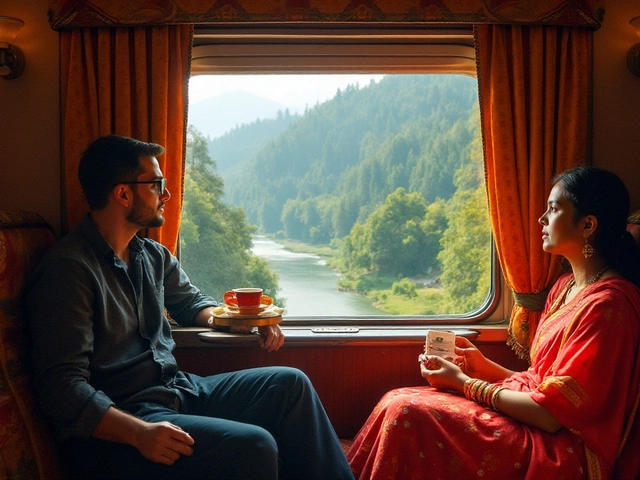When you think of the most eaten food in India, rice and curry might first spring to mind. But the reality is, Indian cuisine is as diverse as its culture, with staples that vary from north to south. One might find the heartwarming simplicity of rice and dal in the south, while up north, wheat-based roti or paratha rule the plate.
Travelling through India on a budget doesn't mean missing out on authentic flavors. In fact, street food and local eateries serve up some of the most beloved dishes, offering a true taste of India without emptying your wallet. Picture chaat stands bustling with activity, as vendors whip up spicy and tangy tidbits for eager food lovers.
Getting to the heart of Indian cuisine is an adventure in itself, where each region has its specialties. From the spicy masalas of Bengal to the coconut-infused curries of Kerala, there's always something new to try. Whether you're in Mumbai slurping on a piping hot vada pav or munching on dosas in Chennai, understanding the local palate is key to experiencing a country's culture.
But where to find all these gems while sticking to a budget? Look no further than bustling food markets, local dhabhas by the roadside, and small, family-run eateries that often serve the most authentic dishes. Not only do you get a truly local experience, but you'll often find that these spots are kind to both your stomach and your pocket.
Staples Across India
When it comes to the food in India, there's an entire world of flavors hidden in the staples that people eat every day. While the specifics can change from one state to another, some items are so fundamental they're eaten just about everywhere. The variety is immense, yet these basic foods form the backbone of Indian diets.
Rice and Wheat: The Basics
Rice is undeniably a major player, especially in the southern and eastern parts of India. It's not just plain white rice; there's biryani, pongal, and even fermented rice dishes like dosa and idli. Up in the north, wheat takes the lead in the form of flatbreads like roti, naan, or paratha. These are prepared fresh in most households and served with various side dishes, either vegetarian or meat-based curries.
Pulses and Legumes
Pulses like lentils, chickpeas, and beans are another essential component. They're cheap, nutritious, and versatile. Dal, a kind of lentil soup, is a universal comfort food found in everyday meals across the subcontinent. Chole (spicy chickpeas) and rajma (kidney beans) are also crowd favorites and often paired with rice or bread.
Data Spotlight: India's Staple Consumption
| Staple | Regions Predominantly Consumed | Average Annual Consumption (kg/person) |
|---|---|---|
| Rice | South, East | 80 |
| Wheat | North, West | 68 |
Spices: The Heart of Indian Food
Without spices, Indian food wouldn't be what it is today. From turmeric, cumin, and coriander to cardamom, cloves, and bay leaves, a typical Indian kitchen is a spice lover's paradise. They not only add flavor but also boast numerous health benefits, making them indispensable in Indian cooking.
Understanding these staples and how they fit into everyday meals in India gives you a clear picture of what the locals cherish. Whether it's a homemade meal or a street-side snack, these ingredients are always in the spotlight.
Adventure at Food Markets
Food markets in India are a whirlwind of colors, sounds, and smells, offering the true spirit of Indian cuisine. These bustling hubs are where you'll get the pulse of what real Indian cuisine tastes like and see how much the locals cherish these popular Indian dishes.
Imagine stepping into Chandni Chowk in Delhi, surrounded by the aroma of freshly fried samosas and jalebi. It's an assault on the senses in all the best ways. Whether it's the Pethas of Agra or the Bikaneri Bhujia stalls, each market offers a snapshot of local flavor and culinary heritage.
The Magic of Street Food
The food markets are where humble snacks set the stage. Aloo tikki, chole bhature, or pav bhaji aren't just meals, they're experiences. Vendors rhythmically ladle out hot curry, skillfully flipping rotis with an ease born of practice. And the bonus? These treats are usually light on the wallet.
For those new to street food, remember a few simple tips: choose stalls with high turnover, as that's where the food will be the freshest. Watch how locals order and eat – it’s a crash course in unwritten etiquettes while saving you from any faux pas.
Keeping It Clean and Safe
While street food is a thrilling adventure, keeping an eye on hygiene is crucial. Opt for stands offering cooked or fried items instead of raw salads and keep a sanitizer handy. Generally, bigger cities like Mumbai and Bangalore have a slight edge in terms of adhering to hygiene standards.
In many markets, it's not unusual to have standardized pricing, making sure you get a fair deal. Here's a quick glance at some market prices:
| Dish | Average Price (INR) |
|---|---|
| Pani Puri (per plate) | 20-30 |
| Vada Pav | 15-25 |
| Masala Dosa | 50-70 |
Remember, food markets aren't just about grabbing a meal. They're about absorbing the local culture with each bite, diving deeper into the heart of Indian cuisine, and savoring every moment of your budget travel in India.

Regional Flavors
Exploring food in India isn’t just about tasting different spices; it’s about embarking on a journey through the country’s rich history and cultural diversity. Each region in India offers a unique taste experience that reflects its geography and cultural influences. Let's take a closer look at this flavorful mosaic.
North India: Rich and Robust
In the north, you’ll find dishes chock-full of creamy gravies and hearty breads. Punjab, for instance, is known for its butter-heavy, flavorful dishes like butter chicken and sarson da saag, usually accompanied by soft naan or roti. Delhites rave about chole bhature - spicy chickpeas with fried bread, a street-side staple that packs a punch in terms of flavor and fills you up without requiring a thick wallet.
South India: Spicy and Tangy
Indian cuisine in the south is dominated by rice-based dishes and tangy, coconut-infused curries. In Tamil Nadu, you’ll encounter the beloved dosa, a crispy, fermented crepe made from rice batter paired with spicy chutney and sambhar. Kerala takes it a notch up with its seafood delights like kerala fish curry drenched in coconut milk and spices, all served with steaming hot rice.
| Region | Popular Dish | Main Ingredients |
|---|---|---|
| Punjab | Sarson da Saag | Mustard Greens, Butter, Spices |
| Tamil Nadu | Dosa | Rice Batter, Lentils |
| West Bengal | Machher Jhol | Fish, Mustard Oil, Potatoes |
| Kerala | Kerala Fish Curry | Fish, Coconut Milk, Tamarind |
East India: Tangy and Earthy
Heading east, the cuisine takes on tangy and earthy flavors. West Bengal is famous for machher jhol - a fish curry that's both simple and deeply flavorful. This dish captures the essence of Bengal as it uses mustard oil and spices to enhance the fresh catch of the day.
West India: Vibrant and Zesty
Maharashtra offers a glorious mixture of street foods, from the famous vada pav to tangy pav bhaji. These dishes are not only a treat for the taste buds, but they’re also light on the pocket, making them travel-friendly for budget-conscious wanderers.
So the next time you find yourself traversing the Indian subcontinent, make sure to savor these popular Indian dishes that define the rich culinary landscape of this incredible nation. Trust me, your taste buds will thank you!
Tips for Eating Economically
Traveling on a budget in India doesn't mean you have to skip on the flavors of real Indian cuisine. Here are some handy tips to ensure you savor the taste without burning a hole in your pocket.
1. Hit the Streets
The charm of Indian street food is unmatched. Foods like vada pav or samosas offer a taste explosion at literally a fraction of the cost you'd find in a traditional restaurant. Look for busy stalls; they often have fresher food due to quick turnover.
2. Trust the Locals
Want to eat where the locals eat? Small family-run eateries or 'dhabas' along highways, and neighborhood joints away from tourist hotspots, usually offer delicious, authentic food at lower prices. Don’t hesitate to ask a local where they prefer to eat!
3. Explore Local Markets
Visiting the local food markets can be both an adventure and a money saver. Markets like Delhi's Chandni Chowk or Chennai's Marina Beach stalls serve everything from spicy chaat to dosas at affordable prices.
4. Try Regional Dishes
Each region has its special foods which are often cheaper in their place of origin due to local availability. For instance, enjoy fresh fish curries in Kerala or savor the rich flavors of biryani in Hyderabad.
5. Stick to Vegetarian
Going vegetarian in India is not only healthy but saves you money. Dishes like dal, paneer masala, or aloo gobi are tasty and less expensive than meat dishes. Plus, the variety is enormous!
6. Sneak in a Combo
Many eateries offer thali, a platter with several dishes, which is great value for money. You've got a bit of everything, from curries to sides and bread, allowing you to experience an array of flavors without ordering multiple dishes.
Bonus Tip: Reusable Water Bottle
Always carry a reusable water bottle. Many restaurants provide filtered water, so there's no need to spend extra on bottled water. Plus, it's environmental-friendly!
| Dish | Approximate Cost (INR) |
|---|---|
| Vada Pav | 15 |
| Masala Dosa | 50 |
| Thali | 100 |
Remember, eating economically in India is not just about saving money but also about experiencing the country's vibrant culinary culture. Bon appétit!



